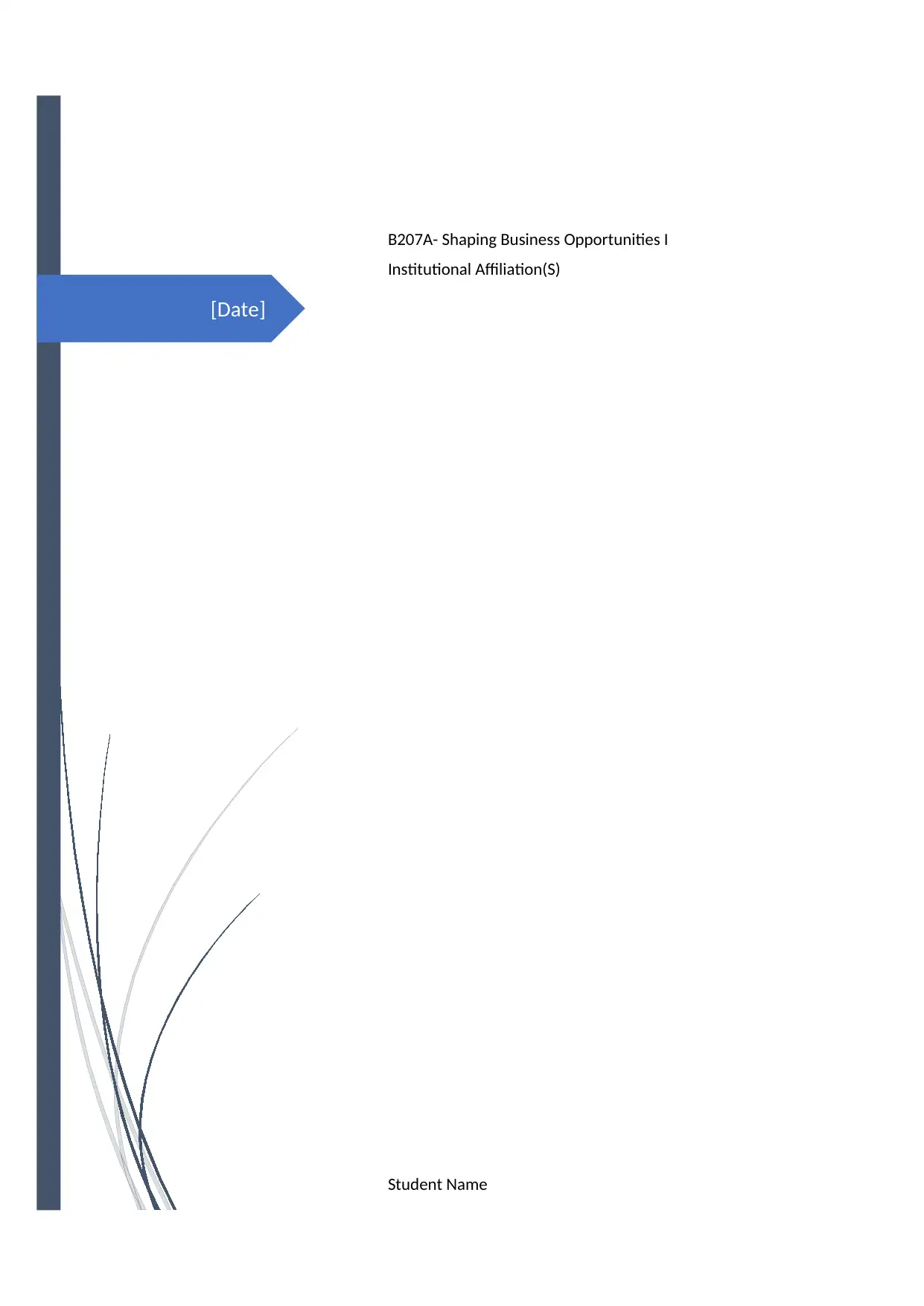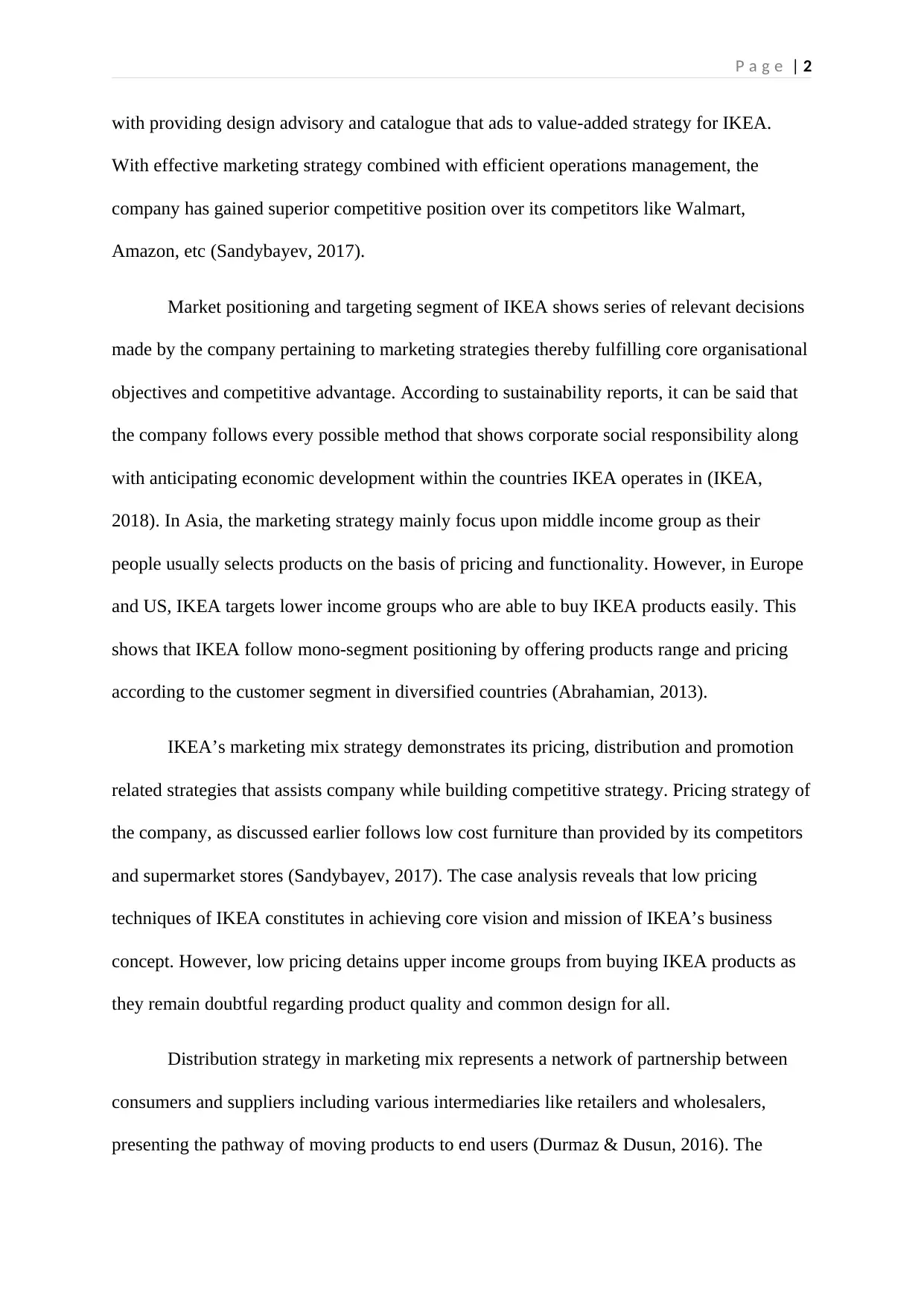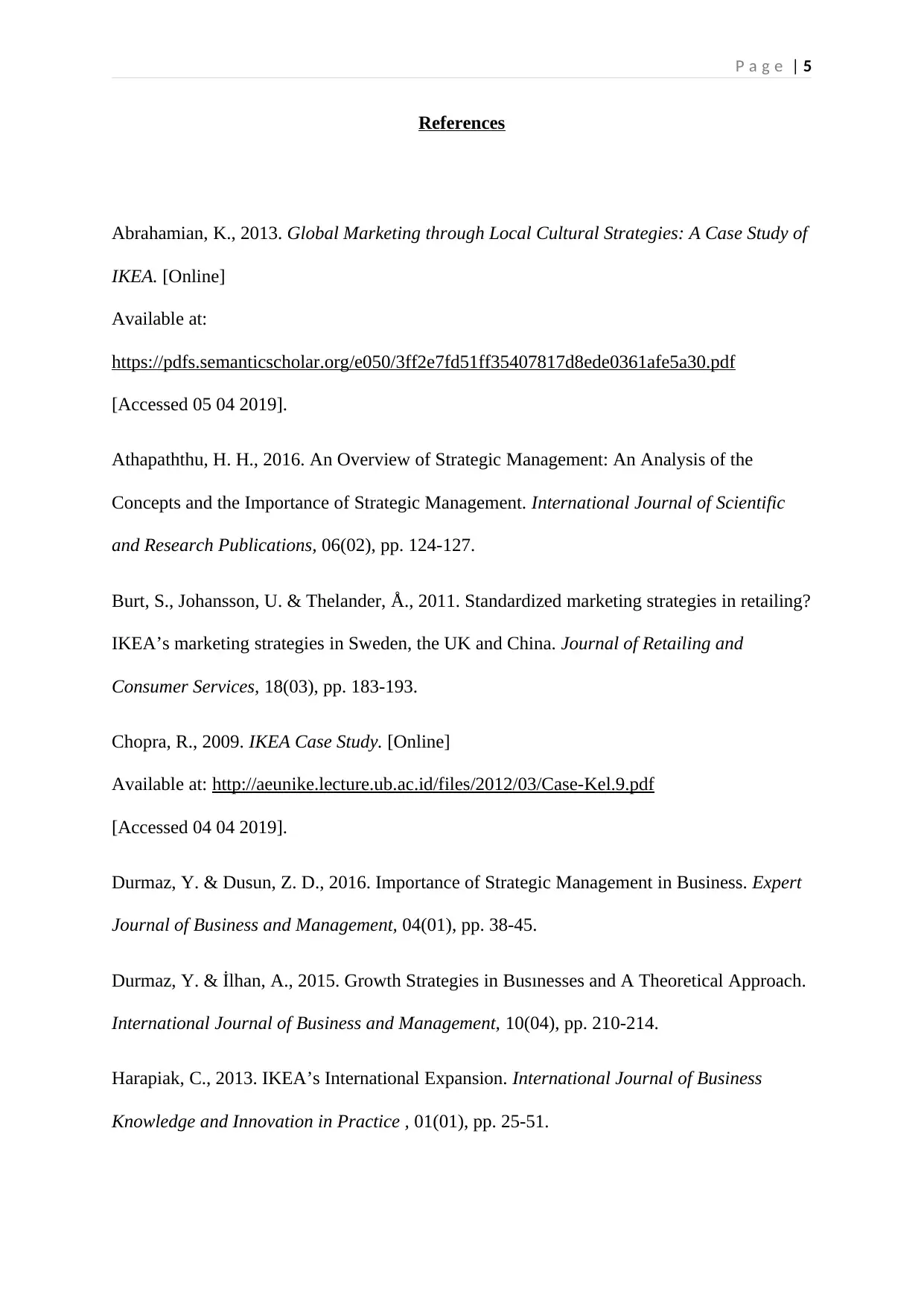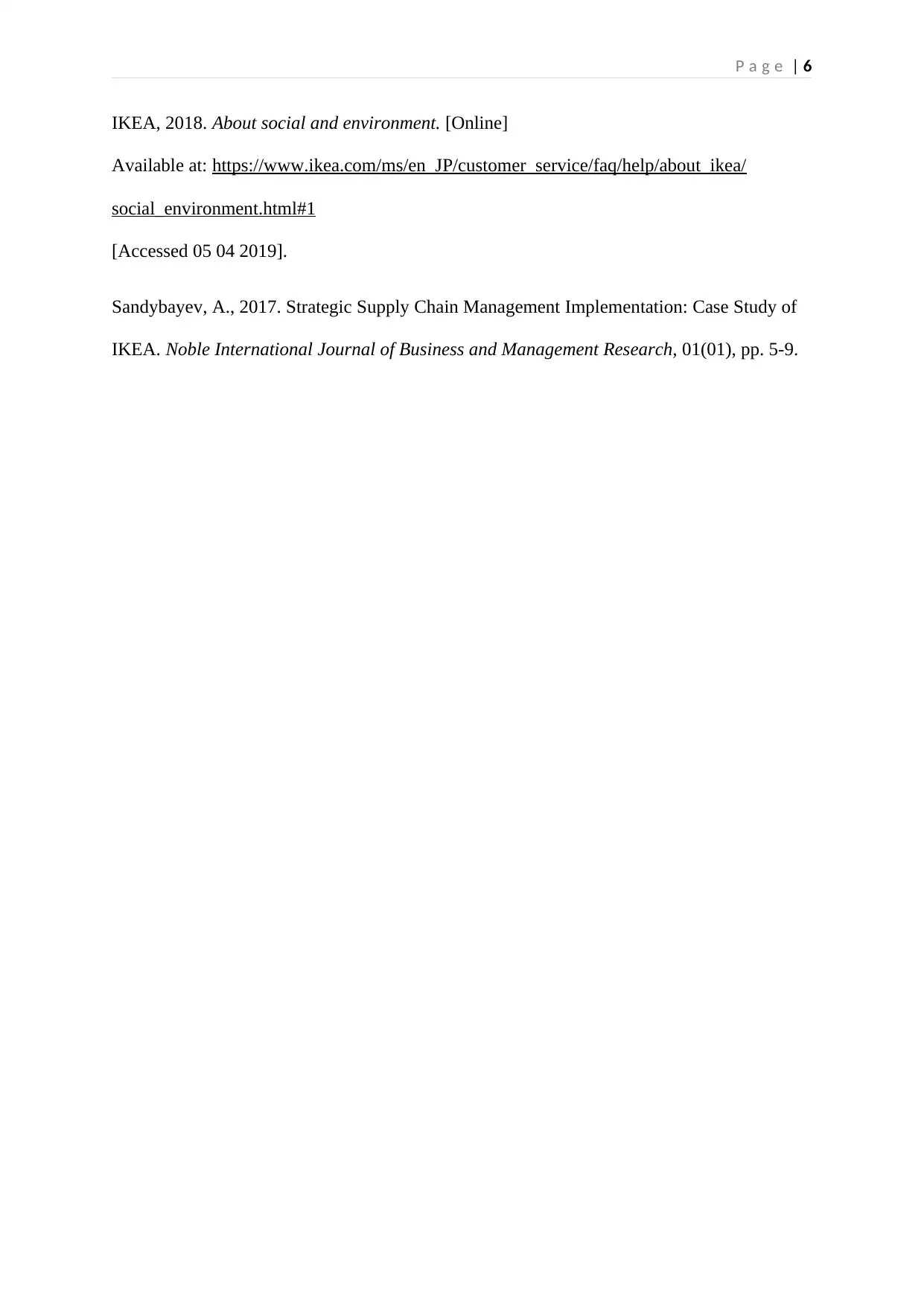Arab Open University B207A: IKEA's Competitive Advantage Analysis
VerifiedAdded on 2023/01/16
|7
|1520
|52
Essay
AI Summary
This essay provides a detailed analysis of IKEA's competitive strategies, marketing, and operations management. It explores how IKEA achieves its competitive advantage through cost reduction, efficient supply chain management, and effective marketing techniques. The essay examines IKEA's product design, market positioning, and pricing strategies, highlighting how these elements contribute to the company's success in the furniture industry. The paper also discusses the importance of operations management, marketing strategy, and their impact on competitive advantage. It concludes that IKEA's integrated approach to business, combining marketing, operations, and competitive strategies, has enabled the company to achieve sustainable growth and a strong position in the global market. The analysis draws on various sources to provide a comprehensive understanding of IKEA's business model and its application in different markets.

[Date]
B207A- Shaping Business Opportunities I
Institutional Affiliation(S)
Student Name
B207A- Shaping Business Opportunities I
Institutional Affiliation(S)
Student Name
Paraphrase This Document
Need a fresh take? Get an instant paraphrase of this document with our AI Paraphraser

P a g e | 1
Essay
Introduction
IKEA, a well-known international brand has strategic business units in almost every
country across the globe. The business strategy of all its units follow common objectives i.e.
provide low-cost furniture and performing better than any other competitor in furniture
industry (Harapiak, 2013). IKEA has few weaknesses also pertaining cost differentiation
strategy that makes many of its customer doubt regarding product quality and thus Brut, Ulf
& Asa (2011) argues that cost differentiation may not provide companies with benefit always.
This essay will make detailed discussions about IKEA’s competitive strategies along with its
operations and marketing management techniques that helps the company gain competitive
position in furniture industry.
Body
The case presented clearly shows that IKEA comprises efficient management and
strong relationships with its suppliers as well as customers due to which they are able to
provide best offers required for gaining competitive position. Cost reduction is another
significant technique seen in IKEA’s competitive strategies. At present, IKEA works with as
many as 1,800 suppliers that provides the company with necessary raw materials at
reasonable rates. In fact, IKEA outsources most of its manufacturing work also that helps the
firm in developing low-cost operations (Abrahamian, 2013).
Stores of IKEA is another advantage that makes brand IKEA prominent in the
marketplace as given in case analysis. The product design strategy of IKEA follows
functional as well as flat packed style, without compromising on quality that helps in
reaching targeted demographics. Another effective competitive strategy of IKEA can be
highlighted through its optimised furniture designs that most of its competitors lack along
Essay
Introduction
IKEA, a well-known international brand has strategic business units in almost every
country across the globe. The business strategy of all its units follow common objectives i.e.
provide low-cost furniture and performing better than any other competitor in furniture
industry (Harapiak, 2013). IKEA has few weaknesses also pertaining cost differentiation
strategy that makes many of its customer doubt regarding product quality and thus Brut, Ulf
& Asa (2011) argues that cost differentiation may not provide companies with benefit always.
This essay will make detailed discussions about IKEA’s competitive strategies along with its
operations and marketing management techniques that helps the company gain competitive
position in furniture industry.
Body
The case presented clearly shows that IKEA comprises efficient management and
strong relationships with its suppliers as well as customers due to which they are able to
provide best offers required for gaining competitive position. Cost reduction is another
significant technique seen in IKEA’s competitive strategies. At present, IKEA works with as
many as 1,800 suppliers that provides the company with necessary raw materials at
reasonable rates. In fact, IKEA outsources most of its manufacturing work also that helps the
firm in developing low-cost operations (Abrahamian, 2013).
Stores of IKEA is another advantage that makes brand IKEA prominent in the
marketplace as given in case analysis. The product design strategy of IKEA follows
functional as well as flat packed style, without compromising on quality that helps in
reaching targeted demographics. Another effective competitive strategy of IKEA can be
highlighted through its optimised furniture designs that most of its competitors lack along

P a g e | 2
with providing design advisory and catalogue that ads to value-added strategy for IKEA.
With effective marketing strategy combined with efficient operations management, the
company has gained superior competitive position over its competitors like Walmart,
Amazon, etc (Sandybayev, 2017).
Market positioning and targeting segment of IKEA shows series of relevant decisions
made by the company pertaining to marketing strategies thereby fulfilling core organisational
objectives and competitive advantage. According to sustainability reports, it can be said that
the company follows every possible method that shows corporate social responsibility along
with anticipating economic development within the countries IKEA operates in (IKEA,
2018). In Asia, the marketing strategy mainly focus upon middle income group as their
people usually selects products on the basis of pricing and functionality. However, in Europe
and US, IKEA targets lower income groups who are able to buy IKEA products easily. This
shows that IKEA follow mono-segment positioning by offering products range and pricing
according to the customer segment in diversified countries (Abrahamian, 2013).
IKEA’s marketing mix strategy demonstrates its pricing, distribution and promotion
related strategies that assists company while building competitive strategy. Pricing strategy of
the company, as discussed earlier follows low cost furniture than provided by its competitors
and supermarket stores (Sandybayev, 2017). The case analysis reveals that low pricing
techniques of IKEA constitutes in achieving core vision and mission of IKEA’s business
concept. However, low pricing detains upper income groups from buying IKEA products as
they remain doubtful regarding product quality and common design for all.
Distribution strategy in marketing mix represents a network of partnership between
consumers and suppliers including various intermediaries like retailers and wholesalers,
presenting the pathway of moving products to end users (Durmaz & Dusun, 2016). The
with providing design advisory and catalogue that ads to value-added strategy for IKEA.
With effective marketing strategy combined with efficient operations management, the
company has gained superior competitive position over its competitors like Walmart,
Amazon, etc (Sandybayev, 2017).
Market positioning and targeting segment of IKEA shows series of relevant decisions
made by the company pertaining to marketing strategies thereby fulfilling core organisational
objectives and competitive advantage. According to sustainability reports, it can be said that
the company follows every possible method that shows corporate social responsibility along
with anticipating economic development within the countries IKEA operates in (IKEA,
2018). In Asia, the marketing strategy mainly focus upon middle income group as their
people usually selects products on the basis of pricing and functionality. However, in Europe
and US, IKEA targets lower income groups who are able to buy IKEA products easily. This
shows that IKEA follow mono-segment positioning by offering products range and pricing
according to the customer segment in diversified countries (Abrahamian, 2013).
IKEA’s marketing mix strategy demonstrates its pricing, distribution and promotion
related strategies that assists company while building competitive strategy. Pricing strategy of
the company, as discussed earlier follows low cost furniture than provided by its competitors
and supermarket stores (Sandybayev, 2017). The case analysis reveals that low pricing
techniques of IKEA constitutes in achieving core vision and mission of IKEA’s business
concept. However, low pricing detains upper income groups from buying IKEA products as
they remain doubtful regarding product quality and common design for all.
Distribution strategy in marketing mix represents a network of partnership between
consumers and suppliers including various intermediaries like retailers and wholesalers,
presenting the pathway of moving products to end users (Durmaz & Dusun, 2016). The
⊘ This is a preview!⊘
Do you want full access?
Subscribe today to unlock all pages.

Trusted by 1+ million students worldwide

P a g e | 3
distribution strategy followed by IKEA shows that the company has a very sound supply and
logistics system. The products manufactured are directly sent to IKEA’s stores thereby
removing any wholesaler or middlemen costs. The company makes constant promotions
through external media source like television, radio, social media and print magazines that
allows brand visibility among end users (Chopra, 2009). The company has huge number of
local suppliers in every country which have IKEA stores that helps company in reducing
outsourcing costs. Alongside, suppliers also try to make long-term contract with IKEA due to
bulk work provisions (Sandybayev, 2017).
To allow smooth flow of process, the stores have dispatch area nearby parking lots
from where customers can easily pick their purchases just before leaving the store. One
unique feature provided by IKEA over its competitors is provision of play area for children
along with inhouse Swedish restaurant to make its customer shopping experience more
pleasurable. Even the logistics and inventory management of IKEA adds to its competitive
advantage as they follow unique system of products reordering that employs in-house logistic
for managing inventories and stock records (Sandybayev, 2017). To consider future
uncertainties, IKEA implements stock inventory after the store is closed at night that ensures
every inventory matches according to stock for that day (Chopra, 2009).
Operations management is another critical part that compliments overall firm’s
competitive strategies. According to Athapaththu (2016), operations strategy specifies firm
about how to employ its operation facilities for supporting its business strategy to gain
competitive advantage. Indeed, this is the reason why most of the firms selects operation
strategy that matches to their competitive position so that they can perform best for defining
their positional supremacy. Marketing strategy is also relevant along with operations
management as together they create with smooth flow of work. Where marketing allows
reaching end consumers, operations management shows path to it (Durmaz & İlhan, 2015).
distribution strategy followed by IKEA shows that the company has a very sound supply and
logistics system. The products manufactured are directly sent to IKEA’s stores thereby
removing any wholesaler or middlemen costs. The company makes constant promotions
through external media source like television, radio, social media and print magazines that
allows brand visibility among end users (Chopra, 2009). The company has huge number of
local suppliers in every country which have IKEA stores that helps company in reducing
outsourcing costs. Alongside, suppliers also try to make long-term contract with IKEA due to
bulk work provisions (Sandybayev, 2017).
To allow smooth flow of process, the stores have dispatch area nearby parking lots
from where customers can easily pick their purchases just before leaving the store. One
unique feature provided by IKEA over its competitors is provision of play area for children
along with inhouse Swedish restaurant to make its customer shopping experience more
pleasurable. Even the logistics and inventory management of IKEA adds to its competitive
advantage as they follow unique system of products reordering that employs in-house logistic
for managing inventories and stock records (Sandybayev, 2017). To consider future
uncertainties, IKEA implements stock inventory after the store is closed at night that ensures
every inventory matches according to stock for that day (Chopra, 2009).
Operations management is another critical part that compliments overall firm’s
competitive strategies. According to Athapaththu (2016), operations strategy specifies firm
about how to employ its operation facilities for supporting its business strategy to gain
competitive advantage. Indeed, this is the reason why most of the firms selects operation
strategy that matches to their competitive position so that they can perform best for defining
their positional supremacy. Marketing strategy is also relevant along with operations
management as together they create with smooth flow of work. Where marketing allows
reaching end consumers, operations management shows path to it (Durmaz & İlhan, 2015).
Paraphrase This Document
Need a fresh take? Get an instant paraphrase of this document with our AI Paraphraser

P a g e | 4
The firm’s competitive strategy establishes strong relationship between every business
strategy to gain position and to control market competition thereby allowing firms to monitor
prices and enable standardised production and distribution that promotes overall corporate
mission and vison. Moreover, in literature, it is been very well cited that competitive
advantage can be gained by firms only if they underline their strategy intent while
formulating various other operational and marketing related strategies (Athapaththu, 2016).
Conclusion
The above essay has been prepared after reviewing various books and online sources
to analyse relationship between marketing, operations and competitive strategy of firms.
After analysing case example of IKEA, this paper concludes on the note that IKEA gains
competitive position as it excels in strategies formulated by company’s management. Every
strategy of IKEA shows how businesses grow and utilises opportunities for gaining superior
position in market. IKEA’s biggest strength lies in its core vision that supports its core
strategies related to marketing, operation and competitive position thereby signifying that
combination of every business strategy results in bringing workplace effectiveness along with
enabling sustainable growth in future.
The firm’s competitive strategy establishes strong relationship between every business
strategy to gain position and to control market competition thereby allowing firms to monitor
prices and enable standardised production and distribution that promotes overall corporate
mission and vison. Moreover, in literature, it is been very well cited that competitive
advantage can be gained by firms only if they underline their strategy intent while
formulating various other operational and marketing related strategies (Athapaththu, 2016).
Conclusion
The above essay has been prepared after reviewing various books and online sources
to analyse relationship between marketing, operations and competitive strategy of firms.
After analysing case example of IKEA, this paper concludes on the note that IKEA gains
competitive position as it excels in strategies formulated by company’s management. Every
strategy of IKEA shows how businesses grow and utilises opportunities for gaining superior
position in market. IKEA’s biggest strength lies in its core vision that supports its core
strategies related to marketing, operation and competitive position thereby signifying that
combination of every business strategy results in bringing workplace effectiveness along with
enabling sustainable growth in future.

P a g e | 5
References
Abrahamian, K., 2013. Global Marketing through Local Cultural Strategies: A Case Study of
IKEA. [Online]
Available at:
https://pdfs.semanticscholar.org/e050/3ff2e7fd51ff35407817d8ede0361afe5a30.pdf
[Accessed 05 04 2019].
Athapaththu, H. H., 2016. An Overview of Strategic Management: An Analysis of the
Concepts and the Importance of Strategic Management. International Journal of Scientific
and Research Publications, 06(02), pp. 124-127.
Burt, S., Johansson, U. & Thelander, Å., 2011. Standardized marketing strategies in retailing?
IKEA’s marketing strategies in Sweden, the UK and China. Journal of Retailing and
Consumer Services, 18(03), pp. 183-193.
Chopra, R., 2009. IKEA Case Study. [Online]
Available at: http://aeunike.lecture.ub.ac.id/files/2012/03/Case-Kel.9.pdf
[Accessed 04 04 2019].
Durmaz, Y. & Dusun, Z. D., 2016. Importance of Strategic Management in Business. Expert
Journal of Business and Management, 04(01), pp. 38-45.
Durmaz, Y. & İlhan, A., 2015. Growth Strategies in Busınesses and A Theoretical Approach.
International Journal of Business and Management, 10(04), pp. 210-214.
Harapiak, C., 2013. IKEA’s International Expansion. International Journal of Business
Knowledge and Innovation in Practice , 01(01), pp. 25-51.
References
Abrahamian, K., 2013. Global Marketing through Local Cultural Strategies: A Case Study of
IKEA. [Online]
Available at:
https://pdfs.semanticscholar.org/e050/3ff2e7fd51ff35407817d8ede0361afe5a30.pdf
[Accessed 05 04 2019].
Athapaththu, H. H., 2016. An Overview of Strategic Management: An Analysis of the
Concepts and the Importance of Strategic Management. International Journal of Scientific
and Research Publications, 06(02), pp. 124-127.
Burt, S., Johansson, U. & Thelander, Å., 2011. Standardized marketing strategies in retailing?
IKEA’s marketing strategies in Sweden, the UK and China. Journal of Retailing and
Consumer Services, 18(03), pp. 183-193.
Chopra, R., 2009. IKEA Case Study. [Online]
Available at: http://aeunike.lecture.ub.ac.id/files/2012/03/Case-Kel.9.pdf
[Accessed 04 04 2019].
Durmaz, Y. & Dusun, Z. D., 2016. Importance of Strategic Management in Business. Expert
Journal of Business and Management, 04(01), pp. 38-45.
Durmaz, Y. & İlhan, A., 2015. Growth Strategies in Busınesses and A Theoretical Approach.
International Journal of Business and Management, 10(04), pp. 210-214.
Harapiak, C., 2013. IKEA’s International Expansion. International Journal of Business
Knowledge and Innovation in Practice , 01(01), pp. 25-51.
⊘ This is a preview!⊘
Do you want full access?
Subscribe today to unlock all pages.

Trusted by 1+ million students worldwide

P a g e | 6
IKEA, 2018. About social and environment. [Online]
Available at: https://www.ikea.com/ms/en_JP/customer_service/faq/help/about_ikea/
social_environment.html#1
[Accessed 05 04 2019].
Sandybayev, A., 2017. Strategic Supply Chain Management Implementation: Case Study of
IKEA. Noble International Journal of Business and Management Research, 01(01), pp. 5-9.
IKEA, 2018. About social and environment. [Online]
Available at: https://www.ikea.com/ms/en_JP/customer_service/faq/help/about_ikea/
social_environment.html#1
[Accessed 05 04 2019].
Sandybayev, A., 2017. Strategic Supply Chain Management Implementation: Case Study of
IKEA. Noble International Journal of Business and Management Research, 01(01), pp. 5-9.
1 out of 7
Related Documents
Your All-in-One AI-Powered Toolkit for Academic Success.
+13062052269
info@desklib.com
Available 24*7 on WhatsApp / Email
![[object Object]](/_next/static/media/star-bottom.7253800d.svg)
Unlock your academic potential
Copyright © 2020–2025 A2Z Services. All Rights Reserved. Developed and managed by ZUCOL.





